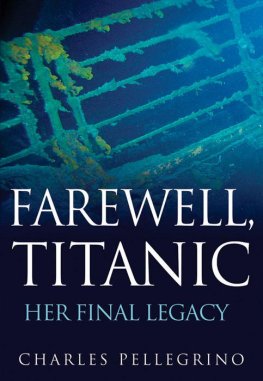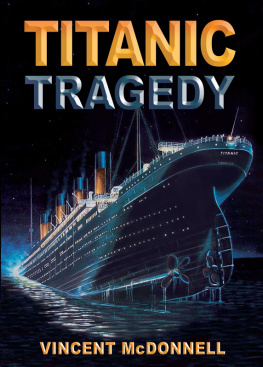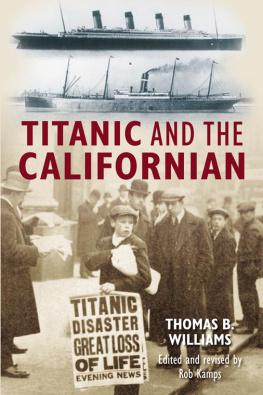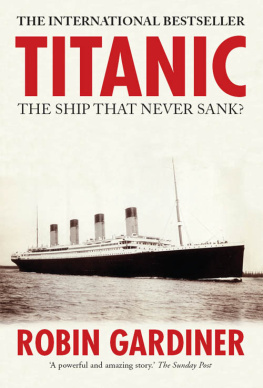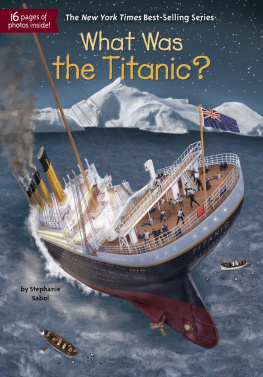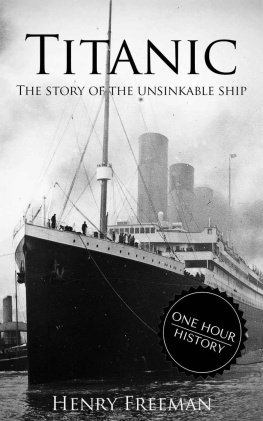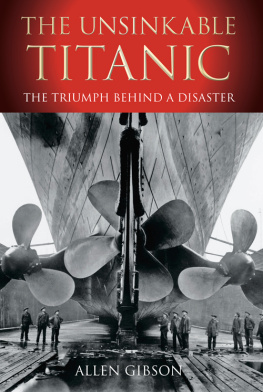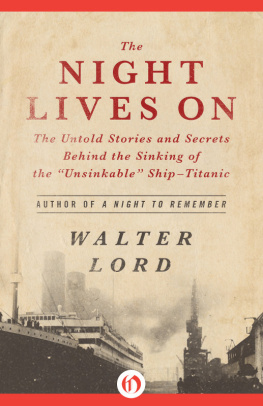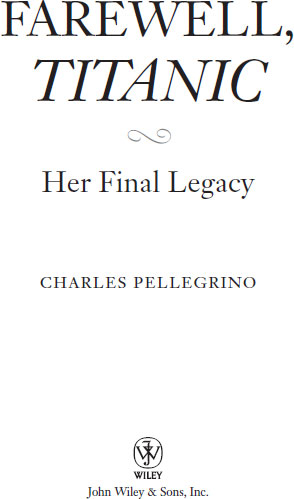Copyright 2012 by Charles Pellegrino. All rights reserved
Design by Forty-five Degree Design LLC
Photo insert credits: pp. 1 (top left, top right), 2 (top left, top right), 13 (middle), Southampton City Council, courtesy of William MacQuitty; pp. 1 (bottom), 2 (bottom), 3, 5, 6, 8 (bottom), 9 (top), 14, Charles Pellegrino; p. 4 (top), James Cameron and Charles Pellegrino; pp. 4 (bottom), 10, 11, 16, Lori Johnston, NOAA; pp. 7, 8 (top), James Cameron; p. 9 (bottom), Leigh Bishop; p. 12, NOAA; p. 13 (top), courtesy of Walter Lord; p. 13 (bottom), Roy Cullimore and Charles Pellegrino; p. 15, Roy Cullimore
Published by John Wiley & Sons, Inc., Hoboken, New Jersey
Published simultaneously in Canada
No part of this publication may be reproduced, stored in a retrieval system, or transmitted in any form or by any means, electronic, mechanical, photocopying, recording, scanning, or otherwise, except as permitted under Section 107 or 108 of the 1976 United States Copyright Act, without either the prior written permission of the Publisher, or authorization through payment of the appropriate per-copy fee to the Copyright Clearance Center, 222 Rosewood Drive, Danvers, MA 01923, (978) 750-8400, fax (978) 646-8600, or on the web at www.copyright.com . Requests to the Publisher for permission should be addressed to the Permissions Department, John Wiley & Sons, Inc., 111 River Street, Hoboken, NJ 07030, (201) 748-6011, fax (201) 748-6008, or online at http://www.wiley.com/go/permissions .
Limit of Liability/Disclaimer of Warranty: While the publisher and the author have used their best efforts in preparing this book, they make no representations or warranties with respect to the accuracy or completeness of the contents of this book and specifically disclaim any implied warranties of merchantability or fitness for a particular purpose. No warranty may be created or extended by sales representatives or written sales materials. The advice and strategies contained herein may not be suitable for your situation. You should consult with a professional where appropriate. Neither the publisher nor the author shall be liable for any loss of profit or any other commercial damages, including but not limited to special, incidental, consequential, or other damages.
For general information about our other products and services, please contact our Customer Care Department within the United States at (800) 762-2974, outside the United States at (317) 572-3993 or fax (317) 572-4002.
Wiley also publishes its books in a variety of electronic formats and by print-on-demand. Some content that appears in standard print versions of this book may not be available in other formats. For more information about Wiley products, visit us at www.wiley.com .
Library of Congress Cataloging-in-Publication Data
Pellegrino, Charles R.
Farewell, Titanic : her final legacy / Charles Pellegrino.
p. cm.
Includes bibliographical references and index.
ISBN 978-0-470-87387-8 (cloth); ISBN 978-1-118-19128-6 (ebk); ISBN 978-1-118-19129-3 (ebk); ISBN 978-1-118-19130-9 (ebk)
1. Titanic (Steamship)History. 2. ShipwrecksNorth Atlantic OceanHistory. I. Title.
G530.T6P443 2012
910.91634dc23
2011049807
To the first responders and other rescuerspast, present, and future
Foreword
by Tom Dettweiler
When I first met Charlie Pellegrino, we of the Dr. Robert Ballard team were in hiding. We had just done the most incredible, wonderful thing: we found the Titanic ! Our lives were suddenly turned upside down. Everybody wanted to know everything about it. We had, however, just experienced an event so exciting yet so disturbing that it was hard to relate to those who had not been there. The world's response was so overwhelming that we had to get away, return to our world of comfort, and return to sea, where life was on our terms and simpler. We had to escape, Bob and all of us, to give ourselves time to come back to reality, fathom what had been seen and accomplished, and put it into proper perspective, one we could deal with. So we set off on a research cruise designated as Argo-RISE, using our robotic sleds to explore the ridge systems in the mid-Pacific, where the planet is creating new volcanic material and new life, which then spreads toward the continents.
Upsetting this escape was the fact that Charlie was going with us with the goal of penetrating our team and finding out everything he could about how similar robots would someday travel into space and be used to explore the distant ice-covered oceans of Europa. As Charlie later told me, this cruise was a life-changing expedition for him. As we reviewed the Titanic pictures we had taken a few short weeks before and talked among ourselves about our find, Charlie was soon infected by the Titanic legend. His questions shifted from space to the Titanic and the voyage of discoverythe very thing we were hiding from.
What we soon realized was that Charlie's questions were coming from a place different from that of the questions we had been bombarded with at home. The question we had grown especially tired of was Did you see any bodies? Charlie was different. Instead of the morbid question about bodies, Charlie asked, Did we see the humans ? In other words, did we see those little bits of evidence that told of their presence, the shreds that defined each individual's character and told his or her unique Titanic storyamong them the story of the forward davit, still turned inboard, a testament to William Murdoch's futile attempt to launch the last lifeboat.
Charlie collected little bits of evidence from us and began piecing together the actual process the Titanic had gone through during the sinking, tracking the debris field backward in time to explain why the wreck appeared as it did on the bottom. Talking to Charlie was like a session on a psychiatrist's couch: he was able to draw out of us the precise things that had such an impact on us when we saw it live. The human drama we were seeing seventy-three years after the fact proved surprisingly disturbing, as our attention was drawn with increasing intensity to that cold Atlantic night in 1912. Finally Charlie was asking the questions that needed to be answered. This began a professional relationship between me and Charlie that has lasted more than twenty-five years, covering many discoveries and topics in ocean exploration, but always firmly tied together by a unique, direct perspective into the Titanic story.
When James Cameron was looking for someone to help develop the characters and add authenticity while making the movie Titanic I introduced him to Charlie. That led to another fruitful professional relationship, one that took Charlie down to the Titanic to experience firsthand the special hold that ship put on all of us, a mystery Charlie describes so well in this book. It's a unique club, and Charlie is one of the few individuals who is able to make his readers feel like a member.
The real treasure that Charlie shares with us in his three Titanic booksespecially in Farewell, Titanic is the intimate human details that resided in such places as the volumes of files accumulated by Walter Lord, the acknowledged dean of the Titanic story. For decades, Titanic survivors had shared their stories with Walter in personal correspondence, and Charlie's access to these files along with his forensic abilities to piece together events and evidence has woven an unprecedented, detailed account that takes you right to the decks of the Titanic on that horrible April night.


